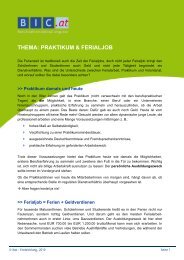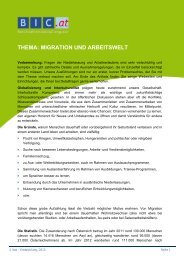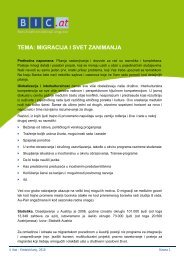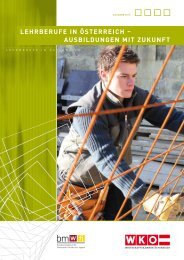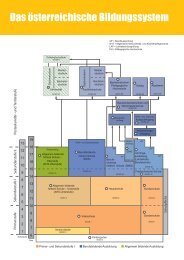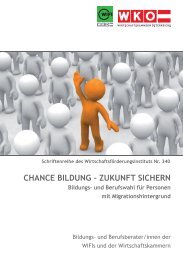The Austrian education system
The Austrian education system
The Austrian education system
Create successful ePaper yourself
Turn your PDF publications into a flip-book with our unique Google optimized e-Paper software.
<strong>The</strong> <strong>Austrian</strong> <strong>education</strong> <strong>system</strong><br />
13<br />
12<br />
11<br />
10<br />
9<br />
8<br />
7<br />
6<br />
5<br />
4<br />
3<br />
2<br />
1<br />
Year<br />
19<br />
18<br />
17<br />
16<br />
15<br />
14<br />
13<br />
12<br />
11<br />
10<br />
9<br />
8<br />
7<br />
6<br />
Age<br />
14<br />
5<br />
19<br />
PhD course<br />
ISCED 6<br />
University<br />
ISCED 5A<br />
Master<br />
degree<br />
course<br />
Bachelor<br />
degree<br />
course<br />
Reifeprüfung examination<br />
Secondary academic<br />
school –<br />
upper cycle<br />
(AHS-Oberstufe)<br />
ISCED 3A<br />
Secondary academic school –<br />
lower cycle<br />
(AHS-Unterstufe)<br />
ISCED 2<br />
Pre-primary <strong>education</strong><br />
ISCED 0<br />
18<br />
Bachelor<br />
degree<br />
course<br />
Fachhochschule<br />
ISCED 5A<br />
13<br />
2<br />
Master<br />
degree<br />
course<br />
Reifeprüfung and diploma examination<br />
VET college<br />
(BHS)<br />
ISCED 4A<br />
Primary school<br />
ISCED 1<br />
1<br />
AP = Abschlussprüfung (Final examination)<br />
G+K = Allgemeine Gesundheits- und Krankenpflegeschule<br />
(School for general healthcare and nursing)<br />
LAP = Lehrabschlussprüfung (Apprenticeship-leave examination)<br />
Nursery school<br />
ISCED 0<br />
4<br />
8<br />
Bachelor degree course<br />
University colleges of<br />
<strong>education</strong><br />
17<br />
10<br />
AP<br />
VET school<br />
(BMS)<br />
ISCED 5B<br />
20 Building craftsperson<br />
school, foreperson course<br />
ISCED 5B<br />
Berufsreife-<br />
prüfung<br />
AP<br />
ISCED 3B<br />
Diploma<br />
examination<br />
9<br />
G+K<br />
ISCED 4B<br />
Lower secondary school<br />
ISCED 2<br />
Postsecondary<br />
VET<br />
course<br />
ISCED 5B<br />
Reifeprüfung or<br />
diploma examination<br />
Add-on course<br />
11 ISCED 4A<br />
7<br />
12<br />
16<br />
Bridging<br />
course<br />
LAP<br />
Apprenticeship<br />
training<br />
(company and<br />
vocational school)<br />
6<br />
3<br />
3<br />
LAP<br />
ISCED 3B<br />
15<br />
Postsecondary<br />
VET<br />
colleges<br />
*<br />
Special needs<br />
school<br />
ISCED 2<br />
Special needs<br />
school<br />
ISCED 1<br />
Primary and secondary level I VET Programme General <strong>education</strong> programme<br />
ISCED 5B<br />
LAP<br />
Prevocational school<br />
ISCED 3C
<strong>The</strong> <strong>Austrian</strong><br />
<strong>education</strong> <strong>system</strong><br />
In Austria, children aged three and over can<br />
attend a nursery school (Kindergarten) (1)<br />
[ISCED 0] voluntarily. As soon as they are<br />
five years old they must attend nursery<br />
school in a half-day form. Kindergarten is<br />
not part of the school <strong>system</strong>, however.<br />
In Austria compulsory schooling starts at<br />
the age of six and lasts for nine years. One<br />
nursery or school year lasts for ten months<br />
(from September to June). <strong>The</strong>re are<br />
private and state schools; in state schools,<br />
no tuition fees are charged. <strong>The</strong> <strong>Austrian</strong><br />
school <strong>system</strong> provides for a variety of<br />
<strong>education</strong> and training options which are<br />
designed to meet the needs and interests<br />
of children and their parents.<br />
Primary level<br />
In Austria every child‘s <strong>education</strong> starts with<br />
four years at primary school (Volksschule)<br />
(2) [ISCED 1]*. Pre-primary <strong>education</strong><br />
[ISCED 0] is provided for children who<br />
have reached compulsory school age (i.e.<br />
at the age of six) but are not yet mature<br />
enough for school (e.g. because they have<br />
difficulties following instruction).<br />
Children with special <strong>education</strong>al needs<br />
can attend either a special needs school<br />
(Sonderschule) (3) [ISCED 1] that is<br />
tailored to their needs or primary school<br />
classes that are run in an integrative<br />
(inclusive) scheme. Primary schools<br />
and special needs schools impart<br />
comprehensive general <strong>education</strong> to all<br />
pupils with the objective of fostering their<br />
social, emotional, intellectual and physical<br />
skills and abilities. Classes for children with<br />
special <strong>education</strong>al needs additionally take<br />
the children’s individual disabilities into<br />
account.<br />
Lower secondary level<br />
<strong>The</strong> first differentiation of the school <strong>system</strong><br />
is at the beginning of lower secondary<br />
level. Schoolchildren have a choice<br />
between two types of school that last<br />
for four years each: these are the lower<br />
secondary school (Hauptschule) (4) and<br />
the lower cycle of secondary academic<br />
school (allgemein bildende höhere Schule<br />
or AHS - Unterstufe) (5) [both ISCED 2].<br />
Schoolchildren with special <strong>education</strong>al<br />
needs can continue attending special<br />
needs school [ISCED 2] from the fifth to the<br />
eighth year. Afterwards they can choose<br />
from among intermediate and higher school<br />
levels depending on their inclinations<br />
and talents. Lower secondary schools<br />
provide schoolchildren with basic general<br />
<strong>education</strong>, preparing them for transfer to<br />
ibw<br />
the upper secondary level and for working<br />
life. <strong>The</strong> lower cycle of AHS aims to impart<br />
a broad and advanced general <strong>education</strong>.<br />
It is offered in three branches with different<br />
focuses: as classical secondary academic<br />
school (klassisches Gymnasium) with<br />
Latin and as secondary academic school<br />
(Realgymnasium) specialising in sciences<br />
or economics. In the 2008/2009 school<br />
year the pilot project new secondary<br />
school (Neue Mittelschule) [ISCED 2] was<br />
launched at lower secondary level. This<br />
is a school for all 10-to-14-year-olds. <strong>The</strong><br />
curricula of a Realgymnasium at the lower<br />
cycle of AHS are valid for new secondary<br />
schools. It is planned to introduce this<br />
scheme as a permanent school form as of<br />
2016.<br />
Upper secondary level<br />
For the majority of <strong>Austrian</strong> schoolchildren<br />
the first school year at upper secondary level<br />
is the final year of compulsory schooling<br />
at the same time. <strong>The</strong>n they can decide<br />
between a vocational (VET) and a general<br />
<strong>education</strong> pathway. VET programmes<br />
are provided within the framework of<br />
apprenticeship training (dual <strong>system</strong>), at<br />
VET schools (BMSs) and VET colleges<br />
(BHSs). General <strong>education</strong> is imparted<br />
at the upper cycle of AHS. Depending on<br />
their interests and inclinations there is<br />
the choice between a classical, business,<br />
science, musical and artistic, or language<br />
focus. Some 80% of schoolchildren opt for<br />
a VET programme after completing lower<br />
secondary level.<br />
VET programmes<br />
Young people who want to attend a VET<br />
programme in the dual <strong>system</strong> after lower<br />
secondary level are obliged to complete<br />
their ninth year of compulsory schooling<br />
first. This is in most cases done at a one-year<br />
pre-vocational school (Polytechnische<br />
Schule) (6) [ISCED 3C]. Due to the variety<br />
of subjects, company visits and practical<br />
days at training workshops provided at<br />
pre-vocational school, students are offered<br />
tailored guidance for their future career<br />
decision. Subsequent apprenticeship<br />
training (Lehrlingsausbildung) is provided<br />
both at the training enterprise (Lehrbetrieb)<br />
(practical training, which makes up some<br />
80% of the training period) and part-time<br />
vocational school (Berufsschule) (7)<br />
[ISCED 3B]. It is the task of these vocational<br />
schools to expand the trainees’ general<br />
<strong>education</strong> and complement the specialist<br />
knowledge and skills they are taught in<br />
the training enterprises. Depending on the<br />
apprenticeship, training lasts between two<br />
and four years, but mostly three years. At<br />
the end of the training, every apprentice<br />
can take an apprenticeship-leave<br />
examination (Lehrabschlussprüfung).<br />
Young people with special <strong>education</strong>al<br />
needs, disabilities or disadvantaged<br />
youths have the possibility to attend an<br />
integrative VET programme (integrative<br />
Berufsausbildung). By training in partial<br />
qualifications which the apprentices agree<br />
on with their company it is possible to<br />
meet the special needs of these young<br />
people. Integrative VET is supervised and<br />
supported by vocational training assistants.<br />
Another VET form of upper secondary level<br />
is VET school (berufsbildende mittlere<br />
Schule or BMS) (8) [ISCED 3B]. It aims to<br />
impart to students the fundamental subjectspecific<br />
skills that enable graduates to<br />
exercise their occupation immediately upon<br />
its completion and also aims to expand their<br />
general <strong>education</strong>. VET schools mostly last<br />
between three and four years, but there are<br />
also one-year and two-year forms.<br />
Schools for general healthcare and nursing<br />
(Schulen für allgemeine Gesundheits- und<br />
Krankenpflege) (9) [ISCED 4B] cannot be<br />
started before successful completion of the<br />
tenth year of schooling. Training is provided<br />
within the dual <strong>system</strong>, with practical<br />
training at a hospital and theoretical<br />
<strong>education</strong> at school. <strong>The</strong>y are completed<br />
with a diploma examination.<br />
Since 1997, graduates of apprenticeship<br />
training, of three- and four-year VET schools<br />
and of schools of healthcare and nursing<br />
have had the possibility to take the so-called<br />
Berufsreifeprüfung (10) examination. It<br />
comprises four partial exams (German,<br />
mathematics, a modern foreign language<br />
and occupation-related specialist area)<br />
and entitles students to transfer to any<br />
post-secondary or tertiary establishment<br />
(higher <strong>education</strong> entrance qualification).<br />
Another way to obtain the higher <strong>education</strong><br />
entrance qualification is by acquiring the<br />
Studienberechtigungsprüfung certificate.<br />
It qualifies holders to study only one specific<br />
specialist area, however. Another way to<br />
obtain the access requirements for the postsecondary<br />
and tertiary sector is to complete<br />
an add-on course (Aufbaulehrgang) (11)<br />
[ISCED 4A]. Particular groups of people<br />
have to attend a preparatory or bridging<br />
course (Vorbereitungslehrgang) (12)<br />
before entering this <strong>education</strong>al track.<br />
Graduates of add-on courses are awarded<br />
a Reifeprüfung or diploma certificate.<br />
Apart from apprenticeship training and<br />
vocational programmes provided by VET<br />
schools, students who have completed<br />
lower secondary level also have access<br />
to a VET college (berufsbildende höhere<br />
Schule or BHS) (13) [ISCED 4A], which
provides higher vocational qualifications<br />
in different specialisations (e.g. tourism,<br />
mechanical engineering, electrical<br />
engineering, etc.) and well-founded general<br />
<strong>education</strong>. VET colleges last for five years<br />
and are completed with the Reifeprüfung<br />
and diploma examination. Students thus<br />
acquire professional qualifications and<br />
the general higher <strong>education</strong> entrance<br />
qualification (double qualification).<br />
General <strong>education</strong> programmes<br />
A general <strong>education</strong> is provided to students<br />
by the upper cycle of secondary academic<br />
school (allgemein bildende höhere Schule<br />
or AHS – Oberstufe) (14) [ISCED 3A].<br />
<strong>The</strong>se schools mainly prepare students for<br />
university-based <strong>education</strong> programmes.<br />
<strong>The</strong>y last for four years and are completed<br />
with the Reifeprüfung examination.<br />
Graduates acquire the general higher<br />
<strong>education</strong> entrance qualification.<br />
Post-secondary and tertiary level<br />
Successful completion of AHS or BHS as<br />
well as passing the Berufsreifeprüfung<br />
or Studienberechtigungsprüfung exams<br />
provides students with higher <strong>education</strong><br />
entrance qualifications and hence access<br />
to the following <strong>education</strong> routes: postsecondary<br />
VET colleges (Akademien)<br />
(15) [ISCED 5B], which qualify graduates<br />
to exercise specific activities in the social<br />
services and healthcare sector, and postsecondary<br />
VET courses (Kollegs) (16)<br />
[ISCED 5B], which are mainly oriented<br />
towards AHS graduates who want to<br />
obtain BHS qualifications. For some years<br />
Fachhochschulen have provided tertiary<br />
programmes for specific advanced-level<br />
medical professions, which is leading to a<br />
reduction in the number of post-secondary<br />
VET colleges and schools for general<br />
healthcare and nursing. University<br />
colleges of <strong>education</strong> (Pädagogische<br />
Hochschulen) (17) [ISCED 5B] train<br />
compulsory school teachers in a threeyear<br />
bachelor course. On the basis of<br />
this qualification it is possible - depending<br />
on the chosen subject and credit<br />
modalities - to take up a master study at a<br />
Fachhochschule or university.<br />
At the tertiary level it is possible to enrol<br />
in three-year bachelor and then in at<br />
least two-year master programmes at<br />
Fachhochschulen (18) [ISCED 5A] and<br />
universities (Universitäten) (19) [ISCED<br />
5A]. At both institutions, students may also<br />
enrol in diploma studies. Graduates of a<br />
master course or a diploma study are entitled<br />
to enrol in doctoral studies at universities<br />
[ISCED 6]. In addition, universities,<br />
Fachhochschulen and university<br />
colleges of <strong>education</strong> offer (universitybased)<br />
CVET programmes [ISCED 5A<br />
and 5B] as post-graduate continuing<br />
training programmes or opportunities<br />
for specialisation for graduates. <strong>The</strong><br />
required access qualification is either a<br />
completed study at one of the mentioned<br />
institutions or the general higher <strong>education</strong><br />
entrance qualification in conjunction with<br />
several years of professional experience.<br />
Graduates are awarded the degree<br />
“Akademischer Experte/Akademische<br />
Expertin” (Academic Expert), “MSc”,<br />
“MBA”, “MA”, “LL.M” or “M.A.I.S”.<br />
People over the age of 18 who have<br />
successfully passed the apprenticeshipleave<br />
exam as well as BMS graduates<br />
can deepen their theoretical specialist<br />
<strong>education</strong> at building craftsperson<br />
schools (Bauhandwerkerschulen) and<br />
foreperson courses (Werkmeisterschulen)<br />
(20) [ISCED 5B]. <strong>The</strong>y last for one to two<br />
years and are completed with a final<br />
examination.<br />
Continuing <strong>education</strong> and<br />
training – lifelong learning<br />
People who have completed an initial<br />
vocational training (IVET) pathway at<br />
the upper secondary, post-secondary or<br />
tertiary level and start another stage in<br />
their <strong>education</strong> are usually in continuing<br />
vocational <strong>education</strong> and training (CVET)<br />
programmes. Participants in these CVET<br />
programmes are usually over the age of<br />
twenty. <strong>The</strong> <strong>Austrian</strong> CVET landscape<br />
is characterised by a high degree of<br />
institutional diversity (schools and HE<br />
establishments, <strong>education</strong>al institutions<br />
of the social partners, non-profit CVET<br />
institutions, private providers, etc.) and an<br />
associated wide range of courses.<br />
* ISCED = Internationale Standardklassifikation im Bildungswesen.<br />
Da die Bildungs<strong>system</strong>e der verschiedenen Länder oft unterschiedlich<br />
aufgebaut sind, erleichtert die Angabe von ISCED<br />
deren inhaltlichen Vergleich. ISCED fördert das transnationale<br />
Verständnis von Bildungsgängen und Anerkennungsmöglichkeiten.<br />
Eine Übersicht beziehungsweise detaillierte Erklärung<br />
aller ISCED-Levels bietet das OECD-Dokument Classifying Educational<br />
Programmes. Manual for ISCED-97 Implementation in<br />
OECD Countries (1999).<br />
Bibliography<br />
Schneeberger, Arthur and Nowak, Sabine (2010): Lehrlingsausbildung im Überblick. Strukturdaten, Trends und Perspektiven (Edition 2010) [A Survey<br />
of Apprenticeship Training. Structural Data, Trends and Prospects (2010 Edition)]. ibw research report no. 158, Vienna.<br />
Tritscher-Archan, Sabine und Nowak, Sabine (2010): Berufliche Erstausbildung - Abschlussquoten im postsekundären und tertiären Bereich [Initial<br />
Vocational Training - Graduation Rates in the Post-Secondary and Tertiary Sectors]: www.refernet.at/index.php/berufsbildung-in-oesterreich/statistiken<br />
from 29 March 2011<br />
ibw
Facts and figures about <strong>education</strong><br />
Attractiveness of the VET sector<br />
Vocational <strong>education</strong> and training is<br />
extremely important in Austria: Some 80%<br />
of young people in their tenth school year<br />
sign up to a VET programme.<br />
Source: Schneeberger/Nowak 2010<br />
High importance<br />
of apprenticeship training<br />
Apprenticeship training is highly valued as<br />
a VET path: 40% of the <strong>Austrian</strong> workforce<br />
boast an apprenticeship diploma as their<br />
highest <strong>education</strong>al attainment.<br />
Source: Schneeberger/Nowak 2010<br />
High post-secondary and tertiary<br />
graduation rates<br />
With its post-secondary and tertiary<br />
graduation rates, Austria is clearly above<br />
the EU-19 country mean and the OECD<br />
average.<br />
Source: Tritscher-Archan/Nowak 2010<br />
**Values rounded up to full figures.<br />
25 %<br />
10 %<br />
14 %<br />
6 % 2<br />
%<br />
Ireland 68,7 %<br />
Czech Republic 62,2 %<br />
Switzerland 60,3 %<br />
Denmark 59,2 %<br />
United Kingdom 54 %<br />
Austria 53,4 %<br />
Germany 52,1 %<br />
OECD average 51,9 %<br />
Poland 49,1 %<br />
EU19 average 49,1 %<br />
Portugal 48,7 %<br />
Finland 48,6 %<br />
Slovenia 48 %<br />
Spain 46,4 %<br />
Norway 45,5 %<br />
Sweden 45,3 %<br />
Netherlands 42,8 %<br />
Slovak Republic 42,6 %<br />
Italy 35 %<br />
Hungary 33,3 %<br />
Greece 29,8 %<br />
Turkey 12,1 %<br />
Imprint<br />
© Institut für Bildungsforschung der Wirtschaft, Rainergasse 38, 1050 Wien<br />
Editors: Mag. Silvia Weiß, Mag. Sabine Tritscher-Archan<br />
Artwork and layout: Andrea Groll<br />
Translation: AHA Translation Office, Lange Gasse 11, A 1080 Vienna<br />
4th edition, June 2011<br />
Tab. 1: Distribution of students at grade 10 by school type (2008/09)**<br />
25 %<br />
13 %<br />
40 %<br />
20 %<br />
12 %<br />
41 %<br />
Tab. 2: Formal qualification structure of workforce (2009)**<br />
16%<br />
Tab. 3: Graduation rates in the post-secondary and tertiary sectors (2007)<br />
Apprenticeship training (company and vocational school)<br />
VET school<br />
VET college<br />
Secondary academic school<br />
Compulsory school<br />
Apprenticeship training (company and vocational school)<br />
VET school<br />
VET college<br />
Secondary academic school<br />
Post-secondary VET college<br />
University<br />
0% 10% 20% 30% 40% 50% 60% 70% 80%<br />
Funded by:




